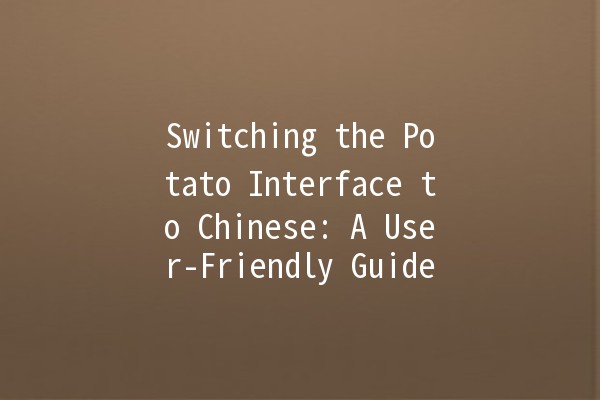In the world of software applications, user experience is paramount. "Potato" offers a distinctive and userfriendly interface that facilitates transitioning between various languages, including Chinese. In this article, we'll delve into practical tips and techniques to manage the Chinese interface switch effectively.
Understanding the Potato Interface
Before we embark on the specifics of switching to the Chinese interface, it’s important to understand what the Potato application is and how its interface functions. Potato is popular for its simplicity and interactive design, making it suitable for a broad spectrum of users—from tech enthusiasts to everyday individuals.

The Importance of Localization
Localization, or the adaptation of software for a specific region or language, is essential for enhancing user experience. A welllocalized interface not only resonates with users culturally but also makes navigation smoother and intuitive.
How to Switch to the Chinese Interface
Switching to the Chinese interface on Potato is a straightforward process. Here are some effective productivityenhancing techniques to facilitate this transition:
The first step in changing the language is to delve into the settings menu. Here’s how you can make the switch:
Access the Menu: Locate the main menu icon, usually represented by three horizontal lines at the top or bottom of the screen.
Select Settings: Click on the settings option, often symbolized by a gear icon.
Choose Language Preferences: In the settings section, find the language preferences option. This is where you can change the interface language.
Practical Example:
Suppose you are currently using English; simply navigate through the menu as mentioned above and select "中文" after clicking on the language option. The interface should refresh automatically—but be sure to check if it retains all your settings!
If you encounter any issues while switching languages, the help section can be invaluable. Here’s how to make the most of it:
Locate Help: Often accessible within the settings menu, this section provides troubleshooting advice and tips for users.
Search for FAQs: Look for commonly asked questions regarding language settings, as they may offer specific solutions tailored to your situation.
Practical Example:
If the language doesn’t change after following the steps, search for “language switch” in the help section. This could lead you to user forums where similar issues are discussed along with solutions.
Sometimes, switching languages can be hampered by outdated software. Keeping your Potato app updated ensures you have the latest features and fixes. Here’s how to do it:
Check for Updates: Go to the app store on your device and see if an update is available for Potato.
Download the Latest Version: If available, download and install it to ensure optimal performance.
Practical Example:
If you're on an Android device, visit the Google Play store, type "Potato" in the search bar, and check if there’s an option to update. Run the update, then retry your language switch.
Leveraging the community can be an excellent way to learn from others who have switched to the Chinese interface. Here’s how you can benefit:
Join Potato Forums: Websites such as Reddit or Potato’s official forums can provide insights and tips directly from users.
Ask Questions: Post your queries regarding the language switch, and fellow users can reply with their experiences or solutions.
Practical Example:
Say you are curious about common problems encountered during the switch; you might ask, “What issues did you face switching to Chinese in Potato?” and gather valuable responses that can guide you.
Once you successfully switch to the Chinese interface, take time to familiarize yourself. Here’s how to enhance your comfort level:
Explore Each Feature: Navigate through various sections of the app to become accustomed to their terminology in Chinese.
Use Reference Materials: Have a bilingual dictionary or translator app on hand for any confusing terms.
Practical Example:
As you use the app, jot down some new terms or phrases that you come across frequently. This will not only aid in understanding the interface better but also bolster your Chinese vocabulary over time.
Common Concerns about Language Switching
Here are some frequently asked questions users might have regarding the switch to the Chinese interface on Potato:
Sometimes updates may not reflect immediately. Make sure to restart the app after changing settings. If issues persist, consult the support section.
Changing the language interface should not affect your saved data. However, it is prudent to back up important information as a precaution.
Yes! You can follow the same steps mentioned above to revert your interface from Chinese back to English.
Potato typically supports a single interface language at a time; you would need to change it manually as needed.
Most features will remain the same, although some localized content might differ depending on the language setting.
Visit the Potato feedback section in the app or on their official website. User feedback is crucial in ensuring the app meets user expectations.
Enhancing Your Productivity with Potato
Switching the Potato interface to Chinese doesn’t just enhance the user experience—it also opens a gateway to understanding and interacting in another language. This can be particularly valuable in today’s globalized environment.
Using the tips outlined above, users can effectively navigate through the process without hassle. By engaging with the features, utilizing community support, and continually practicing, users will transform their use of Potato into a seamless, multilingual experience. Enjoy your journey in mastering both the application and the language! 🍟📱